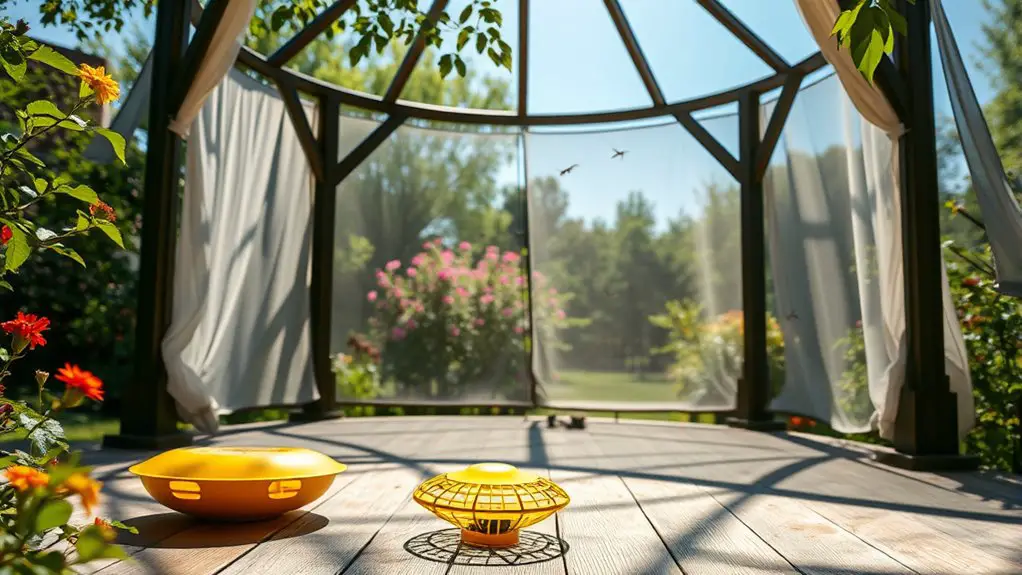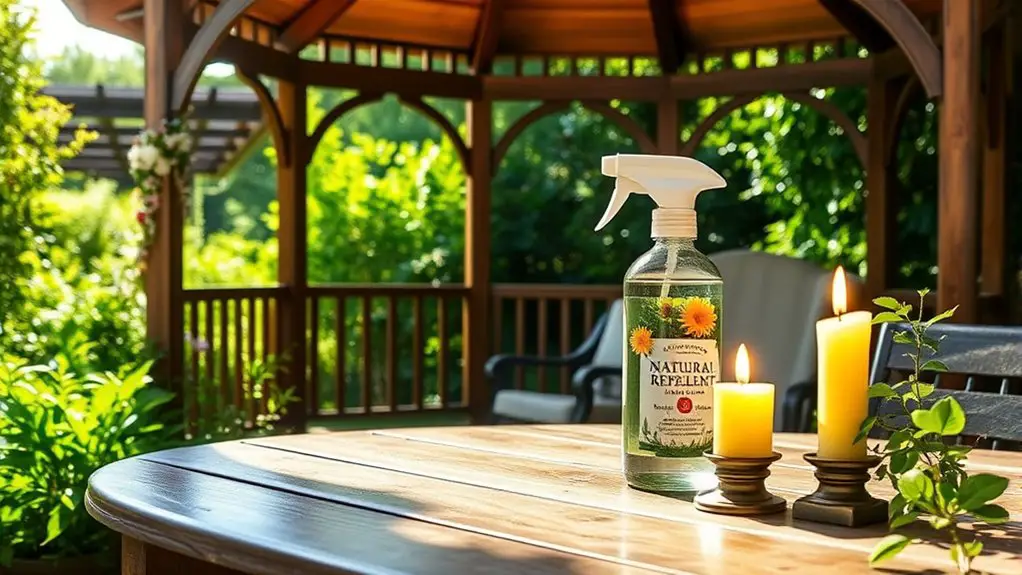To keep your gazebo free from pests and insects, choose a sunny location away from stagnant water. Install fine mesh screens and use durable materials like aluminum or vinyl. Clean regularly to remove debris and clutter that attracts pests. Consider natural repellents like essential oils and introduce natural predators such as ladybugs. Schedule regular pest control treatments to stay ahead of infestations. Discover additional methods to protect your space and enhance its longevity.
Choose the Right Location for Your Gazebo

When selecting a location for your gazebo, it’s essential to take into account factors that minimize pest attraction. Ideally, you should position your gazebo in an area that receives ideal sunlight. Direct sunlight helps reduce moisture, making it less inviting for insects. Avoid placing it near stagnant water sources, such as ponds or poorly drained areas, as these are breeding grounds for mosquitoes.
Additionally, consider wind protection. A location that offers some natural barriers, like trees or shrubs, can help shield your gazebo from strong winds while still allowing for airflow. This balance creates a comfortable environment and discourages pests that thrive in stagnant air. Furthermore, proper orientation can further enhance your gazebo’s pest resistance by maximizing sunlight exposure throughout the day.
Lastly, make sure you have easy access to your gazebo while keeping it at a distance from dense foliage that could harbor unwanted insects. By choosing the right spot, you’ll create a more enjoyable outdoor space, free from pest-related concerns.
Install Screens to Keep Insects Out
Installing screens is one of the most effective ways to keep insects out of your gazebo. By choosing the right screen types and following some essential installation tips, you can create a comfortable outdoor space free from pests. Here are four key considerations:
Installing screens is crucial for a pest-free gazebo, ensuring comfort and airflow while blocking insects effectively.
- Screen Mesh: Opt for fine mesh screens that block even tiny insects while allowing airflow.
- Frame Material: Use durable materials like aluminum or fiberglass to withstand weather conditions.
- Installation Method: Consider retractable screens for versatility; they can be opened or closed as needed.
- Sealing Gaps: Verify that screens fit tightly against the gazebo structure to prevent any gaps where insects can enter. Additionally, properly sealing all doors and windows is crucial to ensure that no insects find their way inside.
Use Natural Repellents and Essential Oils

While screens provide a solid barrier against pests, incorporating natural repellents and essential oils can further enhance your gazebo’s protection. Using essential oil blends, like those from citronella, eucalyptus, and lavender, can help deter insects while creating a pleasant atmosphere. You can easily create your own natural repellent recipes to suit your needs. Additionally, having a gazebo can enhance outdoor experiences by providing a serene environment for relaxation and social gatherings.
Here’s a quick reference table for effective essential oils and their uses:
| Essential Oil | Pest Deterrent | Application Method |
|---|---|---|
| Citronella | Mosquitoes | Diffuser or spray |
| Eucalyptus | Flies, Mosquitoes | Topical or spray |
| Lavender | Moths, Ants | Sachets or spray |
Keep Your Gazebo Clean and Clutter-Free
To maintain a pest-free environment in your gazebo, it is vital to keep it clean and clutter-free. Regular gazebo maintenance not only enhances its appearance but also minimizes the risk of attracting unwanted insects. Here are four essential tips for outdoor organization:
- Remove Debris: Regularly clear leaves, dirt, and other debris that can harbor pests.
- Store Items Properly: Use bins or shelves to organize furniture and accessories, preventing clutter from accumulating.
- Clean Surfaces: Wipe down tables, benches, and railings to eliminate food particles and sticky residues that attract pests.
- Inspect Regularly: Check for signs of nesting or damage, ensuring any issues are addressed promptly. Additionally, regular cleaning helps maintain appearance and prolongs the gazebo’s lifespan.
Set Up Traps for Common Pests

Setting up traps for common pests can greatly reduce their presence in your gazebo, ensuring a more enjoyable outdoor experience. First, utilize effective pest identification methods to determine which insects are invading your space. This knowledge will guide your trap selection.
Next, implement trap placement strategies to maximize effectiveness. For example, place sticky traps near entry points, while baited traps can be positioned where pests are most active.
Here’s a quick reference table to help you:
| Pest Type | Recommended Trap Type |
|---|---|
| Ants | Baited traps |
| Mosquitoes | Sticky traps with attractants |
| Flies | Baited fly traps |
Utilize Citronella Candles and Torches
Using citronella candles and torches can effectively deter a variety of pests, especially mosquitoes, from invading your gazebo. The citronella effectiveness is well-documented, making these products a popular choice for outdoor pest control. For best results, consider the following tips:
- Choose High-Quality Products: Not all citronella candles are created equal; select those with a higher concentration of citronella oil.
- Strategic Candle Placement: Position candles and torches around the perimeter of your gazebo to create a protective barrier.
- Use Multiple Sources: Combine candles with torches to enhance the area’s citronella effectiveness and coverage.
- Regular Replacement: Make sure you replace burnt-out candles and torches promptly to maintain continuous protection.
Maintain Your Garden and Surrounding Areas
While it may seem unrelated, maintaining your garden and surrounding areas plays an essential role in keeping your gazebo pest-free. Regular pruning techniques help eliminate overgrown plants that can attract pests. By removing dead or diseased branches, you improve airflow and reduce hiding spots for insects. Additionally, consider companion planting; certain plants naturally repel unwanted pests. For example, marigolds can deter aphids, while basil can fend off flies. Incorporating climbing plants around your gazebo can also attract beneficial pollinators that help control pest populations.
Here’s a quick reference table for effective gardening practices:
| Practice | Benefit |
|---|---|
| Regular Pruning | Reduces pest habitats |
| Companion Planting | Naturally repels insects |
| Mulching | Controls soil moisture |
| Plant Diversity | Disrupts pest life cycles |
| Cleanliness | Removes debris, pest attractants |
Consider Using Insect-Resistant Materials
When building or maintaining your gazebo, it’s essential to take into account insect-resistant materials. Choosing durable options like treated wood can greatly reduce pest attraction, while incorporating metal elements offers an added layer of protection. By selecting these materials, you can enhance the longevity and pest-resistance of your structure. Additionally, considering the environmental impact of materials can guide you in making more sustainable choices for your gazebo.
Choose Durable Materials
Choosing durable materials for your gazebo is essential, especially if you want to minimize pest problems. Selecting the right materials not only enhances weather resistance but also guarantees cost effectiveness over time. Here are four insect-resistant materials to take into account:
- Aluminum: Lightweight and rust-resistant, it deters pests effectively.
- Vinyl: Non-porous and easy to clean, making it less attractive to insects.
- Composite Wood: Made from recycled materials, it offers durability without attracting pests.
- Fiberglass: Resistant to decay and insects, providing longevity.
Use Treated Wood
In addition to selecting durable materials, using treated wood can greatly enhance your gazebo’s resistance to pests. Wood treatment benefits include the application of chemicals that deter insects and fungi, considerably reducing the risk of damage. These treatments penetrate the wood, offering protection that lasts longer than untreated alternatives. When considering longevity factors, treated wood can withstand harsh weather conditions, preventing rotting and decay that often attract pests. This not only maintains your gazebo’s structural integrity but also minimizes the need for frequent repairs. By choosing treated wood, you’re investing in a pest-resistant structure that can endure the elements while allowing you to enjoy your outdoor space without constant worry about infestations.
Incorporate Metal Elements
Incorporating metal elements into your gazebo design can greatly enhance its resistance to pests. Metal materials are less appealing to insects and can provide a robust barrier against infestations. Here are four effective ways to incorporate metal elements:
- Metal Planters: Opt for metal planters instead of traditional wood to deter pests.
- Decorative Railings: Install decorative railings made of metal, which not only enhance aesthetics but also ward off insects.
- Metal Screens: Use fine metal screens for windows and openings to keep bugs out without sacrificing ventilation.
- Galvanized Hardware: Choose galvanized screws and brackets to prevent rust and extend durability.
Introduce Natural Predators
Introducing natural predators can effectively reduce pest populations in your gazebo. You can attract beneficial insects like ladybugs and lacewings, or release predatory species such as parasitic wasps. By maintaining a balanced ecosystem, you’ll promote a healthier environment that naturally controls pests.
Attract Beneficial Insects
Attracting beneficial insects is one of the most effective strategies for maintaining a pest-free gazebo environment. By introducing these natural allies, you can create a balanced ecosystem. Here are four ways to invite beneficial insects:
- Plant beneficial plants: Flowers like marigolds and lavender attract pollinators and predators.
- Create insect habitats: Leave areas of bare ground or plant native grasses to encourage nesting.
- Provide water sources: Small dishes with pebbles can offer hydration without drowning insects.
- Avoid pesticides: Chemicals can harm beneficial insects, disrupting the balance you’re trying to achieve.
Release Natural Predators
While maintaining a pest-free gazebo, releasing natural predators can greatly enhance your efforts. By introducing native species of predator insects, you’ll create a natural balance that helps control pest populations without harmful chemicals. These beneficial insects actively hunt common pests, reducing their numbers effectively.
| Predator Insect | Target Pests |
|---|---|
| Ladybugs | Aphids, Mites |
| Lacewings | Thrips, Mealybugs |
| Parasitic Wasps | Caterpillars, Aphids |
To maximize their impact, release these predators during peak pest activity. By embracing nature’s own solutions, you can protect your gazebo while enjoying a more liberated, eco-friendly approach to pest management.
Maintain Balanced Ecosystem
To maintain a balanced ecosystem in your gazebo, it’s essential to incorporate natural predators into your pest management strategy. This approach not only helps control pests but also enhances biodiversity benefits, contributing to overall ecosystem balance. Here are some effective natural predators to take into account:
- Ladybugs – These insects feed on aphids and other harmful pests.
- Lacewings – Their larvae consume pests like thrips and mealybugs.
- Parasitic Wasps – They target pest species, laying eggs inside them.
- Birds – Attracting birds can help manage larger pest populations.
Schedule Regular Pest Control Treatments
Scheduling regular pest control treatments is vital for maintaining a pest-free gazebo, especially since insect infestations can quickly escalate if left unchecked. By implementing preventive measures and scheduling seasonal treatments, you can effectively minimize the risk of pest invasions.
| Treatment Type | Frequency |
|---|---|
| Initial Inspection | Once per season |
| Preventive Spraying | Every 3 months |
| Seasonal Treatments | Spring & Fall |
| Monitoring Visits | Monthly |
| Emergency Treatments | As needed |
These treatments not only protect your gazebo but also enhance your outdoor experience. You’ll enjoy peace of mind knowing that proactive measures are in place. Collaborating with a professional pest control service guarantees that the treatments are tailored to the specific needs of your gazebo, optimizing protection while allowing you to fully enjoy your outdoor space.
Frequently Asked Questions
What Are the Best Plants to Deter Insects Near a Gazebo?
To deter insects near your gazebo, consider establishing an herb garden with plants like basil, mint, and lavender. Utilize companion planting to enhance these herbs’ effectiveness, creating a natural barrier against unwanted pests while enjoying your space.
How Often Should I Clean My Gazebo to Prevent Pests?
To guarantee effective pest prevention, you should clean your gazebo at least once a month. Regular cleaning frequency helps eliminate debris and potential breeding grounds, reducing the likelihood of unwanted pests taking residence.
Can Weather Conditions Affect Pest Presence in My Gazebo?
Yes, weather conditions greatly impact pest presence. For instance, temperature fluctuations and high humidity levels can increase pest activity by 30%. It’s essential to monitor these factors to maintain a pest-free environment for your gazebo.
Are There Specific Times of Year When Pests Are More Active?
Yes, specific times of year see increased pest activity due to seasonal pest activity and pest breeding cycles. Typically, spring and summer months experience surges, so being proactive during these periods is essential for prevention.
What Are the Signs of a Pest Infestation in My Gazebo?
Imagine your gazebo as a castle under siege. Look for droppings, gnaw marks, or unusual noises; these are signs of invasion. Employ pest identification techniques and follow gazebo maintenance tips to reclaim your fortress.

